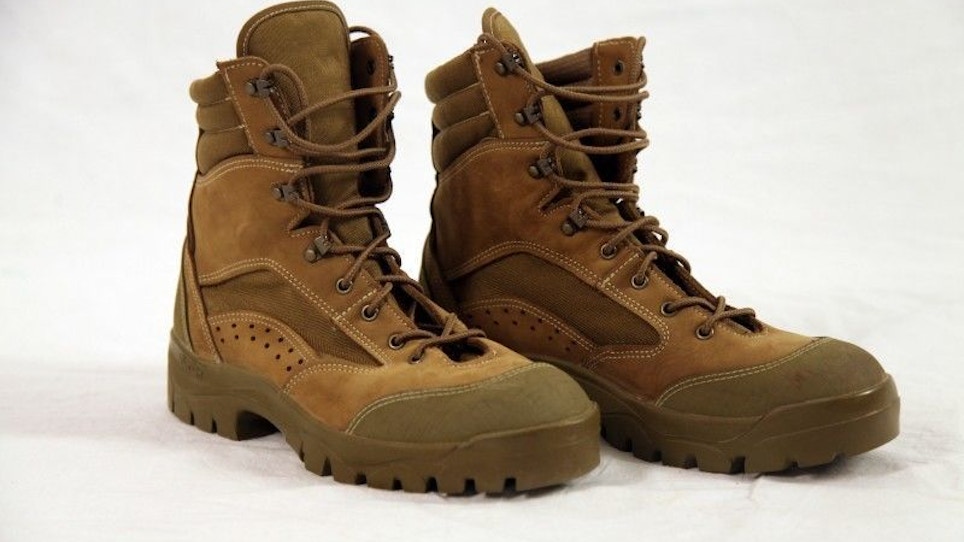With the Army’s current transition from the Universal Camouflage Pattern to the new Operational Camouflage Pattern beginning July 1, 2015, focus is going to shift on Army footwear.
The new clothing ensemble for soldiers consists of an improved Army Combat Uniform in OCP, a cap, brown undergarments and belt, as well as a coyote version of the combat boot. Coyote is a rich brown color that is currently found on Marine Corps boots.
While there are performance specifications for issue military footwear, customers will often purchase specialized boots for different applications such as cold weather or jungle or mountain use. However, most will be looking for a boot that can be used for day-to-day garrison wear.
For soldiers, Army Regulation 670-1 governs “Wear and Appearance of Army Uniforms and Insignia.” Earlier this year, the service also released Department of the Army Pamphlet 670-1 “Guide to Wear and Appearance of Army Uniforms and Insignia.” Think of the AR as a rulebook and the DA PAM as a how-to guide for actual wear. Generically, soldiers will ask for AR 670-1 boots.
If you cater to members of the Army, Army Reserve or National Guard, I suggest you download copies of both the AR and DA PAM, which are freely available on the Internet. They both contain a wide variety of information valuable to the military outfitter.
The most common government issue footwear item is the Army Combat Boot, HW (Hot Weather) that is given to new recruits at basic training. Each soldier is required to possess one pair of Hot Weather combat boots and one pair of Temperate Weather combat boots, which are issued in basic training. Soldiers will often wish to supplement these with something with a different fit or style.
Issue footwear, manufactured to Mil-Spec, are all built on a common last, which is the model used for the size and shape of the boot’s lower, or the section that contains the foot. This means that if the issue boot doesn’t fit a soldier’s foot, trying the same boot by a different manufacturer won’t do any good. This is where tactical retailers come in. Instead, you’ll need to direct the soldier to some commercial options.
If a customer asks you whether a boot is AR 670-1 compliant, consider these comments made last year by former Sergeant Major of the Army, Ray Chandler.
“The Army authorizes [commercial] boots as long as they are between 8 to 10 inches in height and made of tan rough side out of cattle hide leather, with a plain toe and with a soling system similar in color to the tan upper materials. The soling materials cannot exceed two inches in height, when measured from the bottom of the outsole, and cannot extend up the back of the heel of the boot or over the top of the toe.
“There are other leathers, such as pigskin, that do not meet the performance criteria of cattle hide,” Chandler continued. “Cattle hide leather is more durable and provides better performance in combat over pigskin. Soldiers should be aware that some companies sell ‘Warrior Leather,’ which is a common-use name for pigskin leather.
“Rubber and polyether polyurethane are the only outsole materials authorized. Rubber and polyether polyurethane are the only outsole materials that currently meet the need for durability and traction on surfaces in multiple environments and temperature ranges, other materials, which may be of a lighter weight, do not meet soldier’s performance standards.”
Issue footwear — whether it is handed out via initial issue points at basic training centers or sold in Army Military Clothing Sales stores — is procured from vendors by the Defense Logistics Agency’s Troops Support at Defense Supply Center Philadelphia.
Earlier this year, the Army’s Program Executive Office - Soldier attempted to implement the Uniform Quality Control Program for footwear, which would have required commercial boot manufacturers submit samples to the Army to ensure they meet the same color, material and performance specifications of issue items. This program primarily affected those firms that offer Berry-compliant manufacture and also sell to DLA and wanted to sell items via AAFES.
The upside to boots that were built to the UQCP standard is that the manufacturers have been meticulous in ensuring all of the boot’s components are color matched and meet the Army’s shade requirements. These boots will also be AR 670-1 compliant. The same cannot be said of every commercially available boot. Shading in particular might be an issue, since the Army wants all components of the boots to match regardless of material.
UQCP was placed on indefinite hold in May and resulted in many of the manufacturers who also make issue boots being behind the curve in building commercial versions of those items. They waited to begin manufacturing until the Army got the program underway, concerned that they might not receive certification to sell through AAFES. Since UQCP was placed on hold so close to the transition date of July 1, they will be late delivering their wares.
Companies that only manufacture overseas for commercial sale were unaffected by UQCP; and if they anticipated the transition to coyote boots, they will have more inventory available than most domestic sources of supply.
Once again, because the supply of commercial versions of the new issue coyote-colored boots won’t meet initial demand, there is a great mid-term opportunity for alternative boots. However, don’t fret if you still have a large supply of the older tan-colored models. The Army has authorized soldiers to continue to wear the tan boot with the new OCP uniform until 2018. While the tan boot can be worn with the old UCP uniform as well as the new OCP version of the Army Combat Uniform, the coyote boot cannot be worn with the old UCP uniform.
Soldiers will seek out coyote boots to match their new OCP uniforms. This is a great opportunity to put them in some new footwear.





